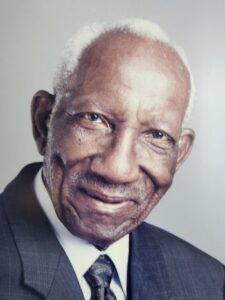
Philip Simmons
*Philip Simmons was born on this date in 1912. He was a Black artisan and blacksmith specializing in the craft of ironwork.
Philip Simmons was born in Daniel Island, South Carolina. His grandparents raised him before being sent to Charleston in 1920 to live with his mother when he was 8. Simmons resided on Vernon Street and enrolled at the Buist Elementary School. Later in life, Simmons would design and create the iron arch, which now stands over the school's entry gate.
Simmons became interested in the craftspeople who lived in his neighborhood and soon began visiting various workshops near his home. He became interested in a smithy on Charlotte Street run by Peter Simmons, which is unrelated to Philip. Philip Simmons soon quit school and began an apprenticeship with Peter Simmons. After a five-year apprenticeship, he became a full blacksmith when he was 18. In 1938, Simmons began working with ornamental and decorative ironwork at his blacksmith shop.
In the early 1940s, he began working with a Charleston businessman, Jack Krawcheck. Krawcheck commissioned a wrought iron gate for the rear of his store on King Street. This was the first iron gate Simmons ever crafted and delivered to a customer. The Krawcheck family would acquire over 30 iron pieces from Simmons as an iron artisan. Simmons created over 500 pieces throughout his career, including iron balconies, window grilles, fences, and gates. In 1976, he created a "star and fish gate" for the Smithsonian Institution, designed to look like the fish was swimming. Simmons also created smaller metal objects to supplement his income, including tools, shutter dogs, and fireplace pokers.
Most of his work was created at his workshop at his home on Blake Street. Simmons spent 78 years as a blacksmith, focusing on decorative ironwork. When he began his career, blacksmiths in Charleston made practical, everyday household objects like horseshoes. By the time he retired 77 years later, the craft was considered an art form rather than a practical profession. Examples of his Art, including iron gates, can be seen throughout Charleston and the South Carolina Lowcountry. His pieces are at the Smithsonian Museum, South Carolina State Museum, Paris, France, and China.
John Michael Vlach, an author and professor of American studies at George Washington University, penned a biography of Simmons and his work in a 1981 book, Charleston Blacksmith: The Work of Philips Simmons. The book was re-released as a second, updated edition eleven years later. The National Endowment for the Arts gave Simmons a National Heritage Fellowship in 1982.
During his acceptance speech at the ceremony, which Simmons gave following a performance by a blues group, Simmons remarked, "My instrument is an anvil. I guess some of you have heard me play a tune on the Anvil, the old blacksmith tune. I'm proud of that, Anvil. I'm really proud. That Anvil fed me when I was hungry, and that Anvil clothed me when I was naked. That Anvil put shoes on my feet."
He continued to teach his craft to younger artisans late into his life. In 1991, the Vestry of his church, St. John's Reformed Episcopal Church, formed the Philip Simmons Foundation, a nonprofit 501(c)(3) organization to develop and maintain a commemorative garden on the grounds of the church as a tribute to the man and his work. The church and garden are at 91 Anson Street in downtown Charleston, South Carolina. In 2004, a gate designed by Simmons and executed by artisans he taught received a commemorative plaque from the General Services Administration's Art in Architecture Program.
A documentary titled Keeper of The Gate on his life won the 1995 Southeastern Regional Emmy Award in the Cultural Documentary category. In 2006, Simmons received an honorary doctorate from South Carolina State University for his contributions to the field of metalworking. In the spring of 2008, he moved from his home to the Bishop Gadsden Retirement Community in Charleston. Phillip Simmons died there on June 22, 2009, at 97.